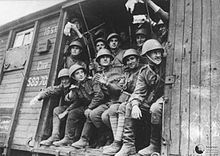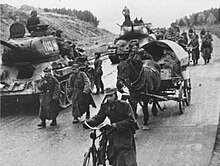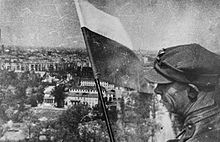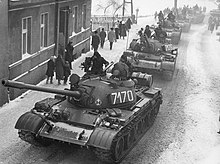Polish People's Army
This article needs additional citations for verification. (August 2021) |
show This article may be expanded with text translated from the corresponding article in Polish. (August 2021) Click [show] for important translation instructions. |
| Polish People's Army | |
|---|---|
| Ludowe Wojsko Polskie | |
 Emblem worn by LWP soldiers; the "Piast eagle" without the crown | |
| Founded | May 1943 |
| Disbanded | 30 December 1989 |
| Service branches | Polish Land Forces Polish Air Force Polish Navy Polish Air Defence Force |
| Headquarters | Warsaw |
| Leadership | |
| First Secretary | Mieczysław Rakowski (last) |
| Prime minister | Tadeusz Mazowiecki (last) |
| Minister of National Defence | Florian Siwicki (last) |
| Chief of the General Staff | (last) |
| Industry | |
| Foreign suppliers | |
| Annual exports | |
| Related articles | |
| History | List of wars involving Poland Timeline of the Polish Army World War II Korean War Vietnam War |
| Ranks | Military ranks of the Polish People's Republic |
The Polish People's Army (Polish: Ludowe Wojsko Polskie pronounced [luˈdɔvɛ ˈvɔi̯skɔ ˈpɔlskʲɛ], LWP)[1] constituted the second formation of the Polish Armed Forces in the East in 1943–1945, and in 1945–1989 the armed forces of the Polish communist state (from 1952, the Polish People's Republic), ruled by the Polish Workers' Party and then the Polish United Workers' Party. The communist-led Polish armed forces, allowed and facilitated by Joseph Stalin, were the result of efforts made in the early 1940s in the Soviet Union by Wanda Wasilewska and Zygmunt Berling.
The official name of those formations were: Armia Polska w ZSRR (Polish Army in the USSR) from 1943–1944, Wojsko Polskie (Polish Troops) and Siły Zbrojne Rzeczpospolitej Polskiej (Armed Forces of the Republic of Poland) from 1944–1952 and from 1952 Siły Zbrojne Polskiej Rzeczypospolitej Ludowej (Armed Forces of the Polish People's Republic). On 7 October 1950, the anniversary of the Battle of Lenino was declared the official "Day of the Polish People's Army" by the authorities of the People's Republic.
History[]
World War II[]

What became the LWP was formed during World War II, in May 1943, as the 1st Tadeusz Kościuszko Infantry Division, which developed into the First Polish Army, unofficially known as Berling's Army. Because of the shortage of Polish officers and the policies of the Soviet Union, in March 1945 Soviet Red Army officers accounted for nearly 52% of the officer corps (15,492 out of 29,372). Around 4,600 of them remained in the LWP by July 1946.[2]
It was not the only Polish formation that fought on the Allied side, nor the first one formed in the East. The earlier Polish force formed in the Soviet Union, known as Anders' Army, was loyal to the Polish government-in-exile and by that time had moved to Iran. The communist-led Polish forces soon grew beyond the 1st Division into two major commands – the First Polish Army (initially under Zygmunt Berling) and the Second Polish Army (commanded by Karol Świerczewski). The First Polish Army participated in the Vistula–Oder Offensive, the Battle of Kolberg and the final Battle of Berlin.[1]
Immediate post-war years[]



After the war the Polish Army was reorganized into six (later seven) military districts. These were the Warsaw Military District, headquartered (HQ) in Warsaw, the Lublin Military District, HQ in Lublin, the Kraków Military District, HQ in Kraków, the Łódź Military District, HQ in Łódź, the Poznań Military District, HQ in Poznań, the Pomeranian Military District, HQ in Toruń, and the Silesian Military District, HQ in Katowice.[citation needed]
In the late 1940s and early 1950s, the Polish Army was under the command of Marshal of the Soviet Union, Marshal of Poland and Minister of Defense of Poland Konstantin Rokossovsky. It was increasingly integrated into Soviet military structures. This process was mitigated in the aftermath of the Polish October of 1956, when Władysław Gomułka formalized aspects of Poland's military relationship with the Soviet Union.[3]
Cold War[]

An anti-Zionist purge in the Polish Army took place in 1968 to systematically remove soldiers of Jewish origin, following Six-Day War between Israel and Arab countries.
Characteristics[]
Uniform[]
In 1949, the first fundamental uniform reform after the war was made.[4] The "Dress Rules for the Soldiers of the Polish Army" were introduced and were to apply from January 1, 1951.
In the Polish People's Army, a soft field cap modeled on the pre-war one was introduced. After the war, the pre-war garrison caps were used again. Stiffened caps were only worn until around 1950, when they were completely replaced by round caps. In 1982, the Polish Rogatywka, modeled on the pattern from 1935, were restored in the Polish Army's Representative Company.[5]
Chaplaincy[]
Throughout the entire period of the existence of the Polish People's Army, its officers and soldiers were provided with pastoral care. Such a service was provided by the General Dean's Office of the Polish Army.[6]
Training[]
In the 1980s, the Polish People's Republic had 4 military academies and 11 higher officers' schools, which trained auxiliary corpsmen and corresponded in rank to higher educational institutions. In 1954, judo instructors from the Warsaw and Krakow institutes of physical culture, participated in the training program for border guards and military personnel of the airborne units of the Polish army.[7]
Engagements[]
- Battle of Lenino - 1943
- Battle of Kolberg - 1945
- Battle of Bautzen - 1945
- Battle of Berlin - 1945
- Anti-communist resistance in Poland (1944–1946)
- Operation Vistula - 1947
- Poznań protests of 1956
- Warsaw Pact invasion of Czechoslovakia - 1968
- Polish protests of 1970
- Pacification of Wujek - 1981
- Martial law in Poland (13 December 1981 – 22 July 1983)
See also[]
- Air Force of the Polish Army
- Polish Armed Forces
- Main Directorate of Information of the Polish Army (GZI WP)
- Internal Military Service (WSW)
- Border Protection Troops (WOP)
References[]
- ^ Jump up to: a b Popularna Encyklopedia Powszechna Wydawnictwa Fogra (2016). "Pierwsza Armia Wojska Polskiego". Encyklopedia WIEM. Cite journal requires
|journal=(help) - ^ Kałużny, Ryszard (2007). "Oficerowie Armii Radzieckiej w wojskach lądowych w Polsce 1945-1956". Zeszyty Naukowe WSOWL (in Polish). AWL. Nr 2 (2): 86–87. ISSN 1731-8157.
- ^ Jerzy Eisler, Siedmiu wspaniałych poczet pierwszych sekretarzy KC PZPR [The Magnificent Seven: First Secretaries of KC PZPR], Wydawnictwo Czerwone i Czarne, Warszawa 2014, ISBN 978-83-7700-042-7, pp. 214–215
- ^ Dziennik rozkazów MON nr 4 z 1949 roku poz.30.
- ^ "Pulk Reprezentacyjny Wojska Polskiego".
- ^ "Duszpasterstwo wojskowe w PRL". sjerzy.parafia.info.pl. Retrieved 2017-09-04.
- ^ Влодзимеж Голембевский. Из-под Фудзиямы на Вислу // журнал «Польша», № 5 (117), май 1964. стр.52-53
- Military history of Poland
- Poland–Soviet Union relations
- Polish Land Forces
- Polish People's Republic
- Military units and formations established in 1943
- Warsaw Pact
- Disbanded armies
- Military units and formations of the Cold War

